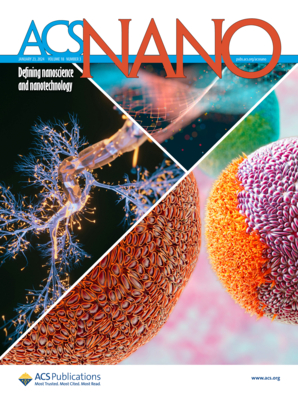Somatostatin and Mannooligosaccharide Modified Selenium Nanoparticles with Dual-Targeting for Ulcerative Colitis Treatment
IF 15.8
1区 材料科学
Q1 CHEMISTRY, MULTIDISCIPLINARY
引用次数: 0
Abstract
Inflammatory bowel disease (IBD) is a prevalent condition worldwide, characterized by complex etiologies, limited efficacy of clinical drug treatments, and potential adverse effects. In this study, we designed 269 nm selenium nanoparticles with double-cell targeting for ulcerative colitis treatment. Somatostatin (SST) and mannooligosaccharide (MOS) were employed to functionalize an Eucommia ulmoides polysaccharide selenium nanoparticle (EUP-SeNP), resulting in the formulation of SST/MOS@EUP-SeNP. Nanoparticles were engineered to target intestinal epithelial cells and macrophages through specific cell surface receptors, enabling dual-targeted treatment. In addition, sodium alginate (SA) microspheres incorporating SST/MOS@EUP-SeNP were prepared for oral administration, protecting the nanoparticles from gastric fluid. The results showed that SA/SST/MOS@EUP-SeNP could preferentially target the inflamed colon tissue and adhere to the colon, enhance the intestinal barrier function, regulate the level of colon inflammation, enhance antioxidant capacity, and regulate the composition of intestinal microbes to effectively relieve the colitis induced by sodium glucan sulfate (DSS). Meanwhile, SA/SST/MOS@EUP-SeNP had excellent biocompatibility both in vivo and in vitro. To some extent, this study can provide a reference for the treatment of IBD.

生长抑素和甘露寡糖修饰硒纳米颗粒双靶向治疗溃疡性结肠炎
炎症性肠病(IBD)是一种世界范围内的常见病,其特点是病因复杂,临床药物治疗效果有限,以及潜在的不良反应。在这项研究中,我们设计了269纳米的双细胞靶向硒纳米颗粒治疗溃疡性结肠炎。利用生长抑素(SST)和甘露寡糖(MOS)对杜仲多糖硒纳米颗粒(EUP-SeNP)进行功能化,得到SST/MOS@EUP-SeNP。纳米颗粒通过特异性细胞表面受体靶向肠上皮细胞和巨噬细胞,实现双靶向治疗。此外,制备了含有SST/MOS@EUP-SeNP的海藻酸钠(SA)微球用于口服,以保护纳米颗粒免受胃液的侵害。结果表明,SA/SST/MOS@EUP-SeNP可优先靶向炎性结肠组织并粘附结肠,增强肠道屏障功能,调节结肠炎症水平,增强抗氧化能力,调节肠道微生物组成,有效缓解葡聚糖硫酸钠(DSS)诱导的结肠炎。同时,SA/SST/MOS@EUP-SeNP在体内外均具有良好的生物相容性。本研究可在一定程度上为IBD的治疗提供参考。
本文章由计算机程序翻译,如有差异,请以英文原文为准。
求助全文
约1分钟内获得全文
求助全文
来源期刊

ACS Nano
工程技术-材料科学:综合
CiteScore
26.00
自引率
4.10%
发文量
1627
审稿时长
1.7 months
期刊介绍:
ACS Nano, published monthly, serves as an international forum for comprehensive articles on nanoscience and nanotechnology research at the intersections of chemistry, biology, materials science, physics, and engineering. The journal fosters communication among scientists in these communities, facilitating collaboration, new research opportunities, and advancements through discoveries. ACS Nano covers synthesis, assembly, characterization, theory, and simulation of nanostructures, nanobiotechnology, nanofabrication, methods and tools for nanoscience and nanotechnology, and self- and directed-assembly. Alongside original research articles, it offers thorough reviews, perspectives on cutting-edge research, and discussions envisioning the future of nanoscience and nanotechnology.
 求助内容:
求助内容: 应助结果提醒方式:
应助结果提醒方式:


